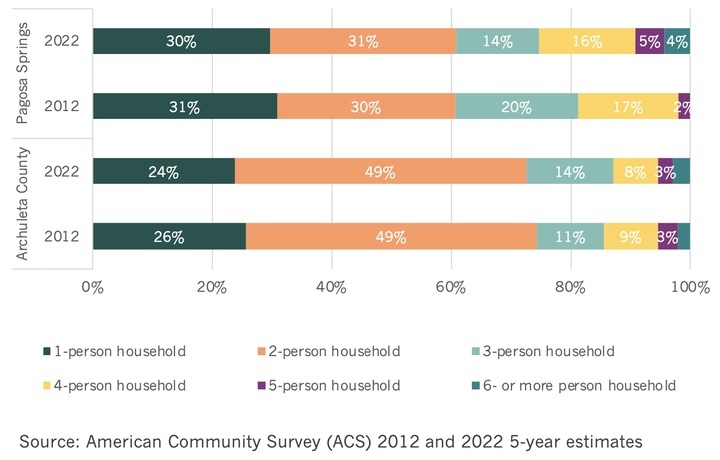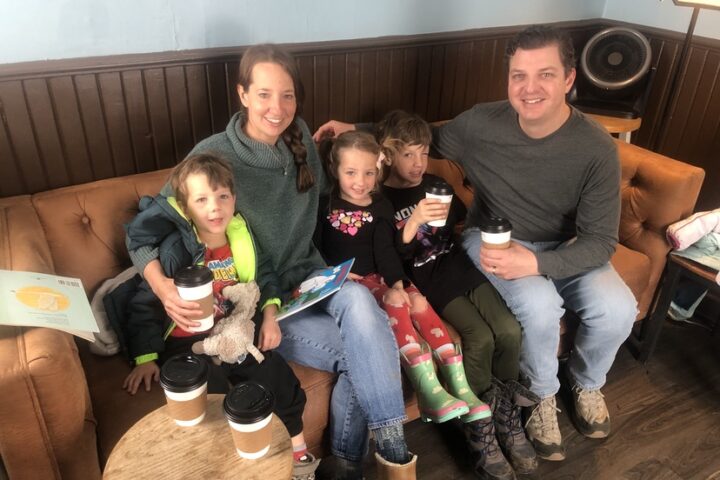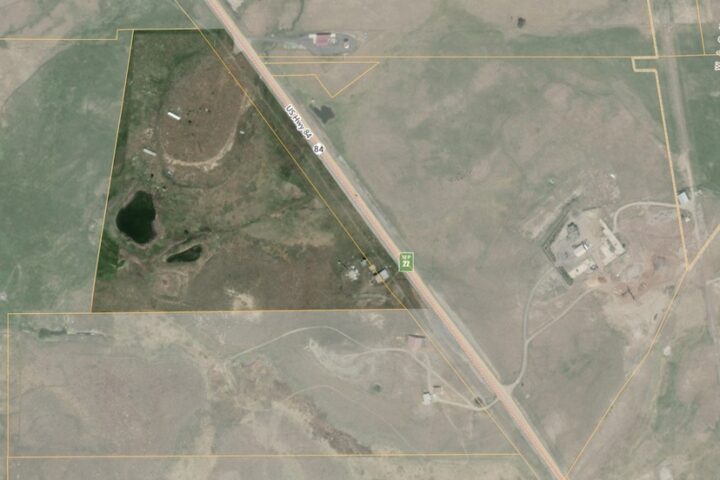Photo: Sarah and Travis Troxtell explain their reasons for requesting rezoning of their property, to allow for a ‘tiny home village’ along Highway 84.
Back in 2021, Pagosa Housing Partners surveyed about 450 employees in Archuleta County, and found that most working households included two persons. This might mean a married couple, or two roommates living together, or a single parent with one child, or some other combination.
Here’s one of the results from the 2021 survey:

If this survey was accurate, more than half of the working families in Pagosa Springs — about 60% — consisted of one or two persons.
The survey was conducted by a local non-profit organization, and was provided — free of charge — to the Town and County governments, in hopes it could help guide their housing policies.
But was it accurate? Because, if we want to address a housing crisis successfully, we probably need to know what size households we’re trying to help.
Last week, the Archuleta Board of County Commissioners and the Pagosa Springs Town Council adopted a Housing Needs Assessment produced by ECOnorthwest and Western Spaces LLC. The 112-page report (which you can download here.) contains dozens of charts displaying data of various types, including this chart:

As we can see here — according to the consultants — our community’s households generally include only one or two persons.fewer. The composition within the town aligns quite accurately with the data from the Pagosa Housing Partners survey from 2021 — about 60% with one or two persons in the household.
The incidence of one- and two-person households out in the unincorporated county is even higher: around 70%.
What we don’t know from this data is the composition of “workforce” households specifically. Are those also mainly one- and two-person households? Or is it mainly retirees who live in one- and two-person households? Because we have our share of retirees here. Maybe more than our share?
We understand that the housing crisis is not hitting everyone in the same way. Nor is everyone struggling in the same way.
One household of five — Sarah and Travis Troxtell and their three kids — believe that a ‘tiny home village’ could be part of the solution.
We shared an editorial series about their proposed project back in March, here in the Daily Post. At the April 15 regular meeting of the Archuleta Board of County Commissioners, the three commissioners — Veronica Medina, Warren Brown and John Ranson — were considering two requests from the Troxtells.
1. Waive the requirement that they apply asphalt paving to the circular driveway that would serve the proposed village, and allow the driveway to be gravel — just like 80% of the public roads in Archuleta County.
2. Change the zoning from ‘agricultural estate” to “mobile home park”.
We’ll get into the pros and cons of these requests later, but we should first consider the fact that, at the same April 15 BOCC meeting where the Troxtells explained these two requests, the three commissioners adopted a new Housing Needs Assessment, which painted — in no uncertain terms — a dire future for the Archuleta County economy, unless some big, bold steps are taken by the community to address the crisis.
There are basically two ways that local governments can address a housing crisis.
1. They can apply taxpayer subsidies and grants, typically tied to deed restrictions, to encourage housing that would otherwise be unaffordable. In other words, they take money that could be used for other types of public services — and in some cases, allocate vacant public land — and apply it to the ongoing crisis.
2. They can modify their regulations, and change their zoning rules, and give waivers to development projects that don’t require taxpayer subsidies. In other words, they can get the hell out of the way of potentially helpful development.
In that regard, the 112-page Assessment included this paragraph:
In its efforts to support a diversity of housing types in Archuleta County, the County is in the process of permitting two tiny home villages. Tiny home villages are small neighborhoods made up of small, tiny homes, often under 400 square feet. The first tiny home village has been approved in 2025 and will feature three tiny homes designated as employer-provided housing. The second Tiny Home Village is still awaiting final approval. If approved as currently proposed, it would include 40 tiny home lots.
This approach is referred to in the Assessment as “Unregulated Affordable Housing” which could also be described as “Unsubsidized Affordable Housing”.
The Troxtells, on April 15, were asking the BOCC to allow them to create affordable housing that would require no government subsidies, but would instead be financed by the people living in the tiny home village. Not only would the project be financed by the owners of the individual tiny homes within the park, but the owners would have a chance to build equity — something that’s become basically impossible for working families who didn’t already own a home here prior to about 2015.
It’s so hard for elected officials to get the hell out of the way.
The parcel out Highway 84 owned by the Troxtells was specifically purchased to become a tiny home village. It already has electric service because it was previously an RV park. The Troxtells have drilled a well to supply water to the future village, and are in the process of designing a community wastewater treatment system to serve up to 40 tiny homes.
But there are a couple of things the BOCC could do to help make this dream a reality.
The BOCC could allow the village driveway to remain gravel. (Like 80% of the County’s own roads.)
And the BOCC could rezone the 26-acre parcel as a mobile home park.
On April 15, the BOCC voted to table those two decisions. We’ll discuss their reasons tomorrow, in Part Four.



